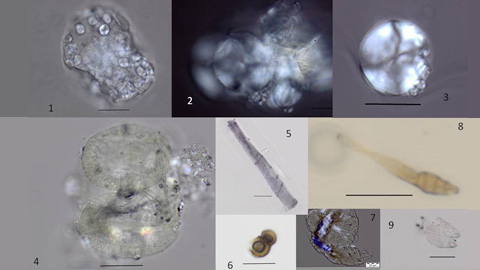Europe’s earliest humans did not use fire

15/12/2016
A new study conducted by researchers from the ICREA, the UAB and the University of York reveals the earliest direct evidence of food eaten by the homo genus in the of the dental plaque of a 1.2 million year old hominin, recovered by the Atapuerca Research Team in 2007 in Sima del Elefante in northern Spain.
The microfossils found in the dental plaque of the molars were identified as including traces of raw animal tissue, uncooked starch granules indicating consumption of grasses, pollen grains from a species of pine, insect fragments, fungal spores and a possible fragment of a toothpick.
All detected fibres were uncharred, and there was also no evidence showing inhalation of microcharcoal – normally a clear indicator of proximity to fire.
Dr Karen Hardy, lead author and ICREA Research Professor at the UAB, said: “Obtaining evidence for any aspect of hominin life at this extremely early date is very challenging. Here, we have been able to demonstrate that these earliest Europeans understood and exploited their forested environment to obtain a balanced diet 1.2 million years ago, by eating a range of different foods and combining starchy plant food with meat.
The timing of the earliest use of fire for cooking is hotly contested with some researchers arguing for habitual use of fire for cooking around 1.8 million years ago, while others suggest it was as late as 300,000-400,000 years ago.
"Possible evidence for fire has been found at some very early sites in Africa. The lack of evidence for fire at Sima del Elefante however suggests that this knowledge was not carried with the earliest hominins when they left Africa. The earliest evidence in Europe for use of fire is 800,000 years ago at the Spanish site of Cueva Negra, and a short time later at Gesher Benot Ya’aqov, Israel. Taken together, this evidence suggests the development of fire technology occurred at some point between 800,000 and 1.2 million years ago, revealing a new timeline for when the earliest humans started to cook food", Karen Hardy points out.
This new timeline has significant implications in helping us to understand this period of human evolution - cooked food provides greater energy, and cooking may be linked to the rapid increases in brain size that occurred from 800,000 years ago onwards.
“It also correlates well with our previous research hypothesising that the timing of cooking is linked to the development of salivary amylase, needed to process cooked starchy food. Starchy food was an essential element in facilitating brain development, and contrary to popular belief about the ‘Paleodiet’, the role of starchy food in the Palaeolithic diet was significant.” the researcher concludes.
Dr Anita Radini, PhD student at the University of York, said: “These results are very exciting, as they highlight the potential of dental calculus to store dietary and environmental information from deep in the human evolutionary past. It is also interesting to see that pollen remains are preserved often in better conditions than in the soil of the same age. Overall this is a very positive step in the discipline, in terms of preservation of material in the calculus matrix.”
Participating in the study, published in The Science of Nature, were also researchers from the National Research Centre on Human Evolution (CENIEH), the Catalan Institute of Human Paleoecology and Social Evolution (IPHES), the Rovira i Virgili University and the University of Sydney.
Original article: Karen Hardy, Anita Radini, Stephen Buckley, Ruth Blasco, Les Copeland, Francesc Burjachs, Josep Girbal, Riker Yll, Eudald Carbonell, Jose María Bermúdez de Castro. "Diet and environment 1.2 million years ago revealed through analysis of dental calculus from Europe’s oldest hominin at Sima del Elefante, Spain." The Science of Nature. DOI 10.1007/s00114-016-1420-x.
Images:
http://www.uab.cat/uabdivulga/img/UAB_CalculoDental_MandibulaAtapuerca_TextCatala.jpg
Microfossils identified in the jaw from Atapuerca. Photo: Karen Hardy
Jaw of the oldest hominin in Europe, discovered in 2007 at the Sima del Elefante site in Atapuerca. Photo: CENIEH